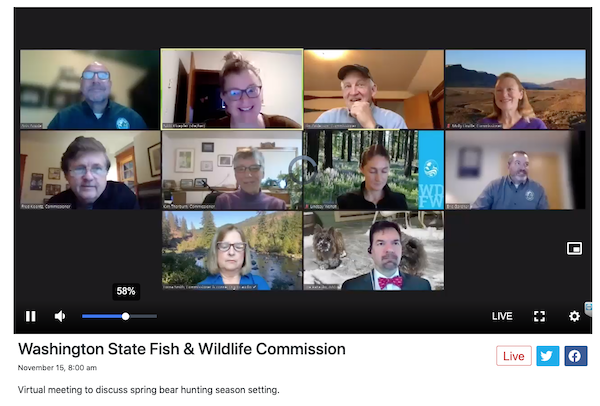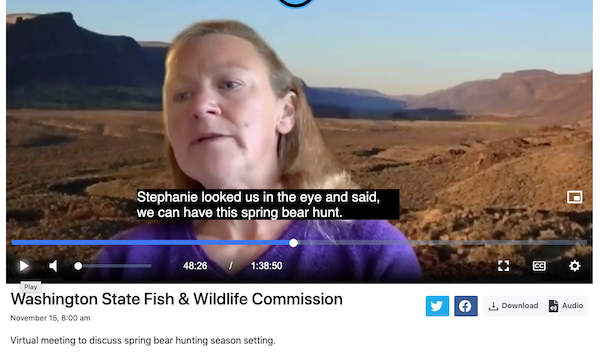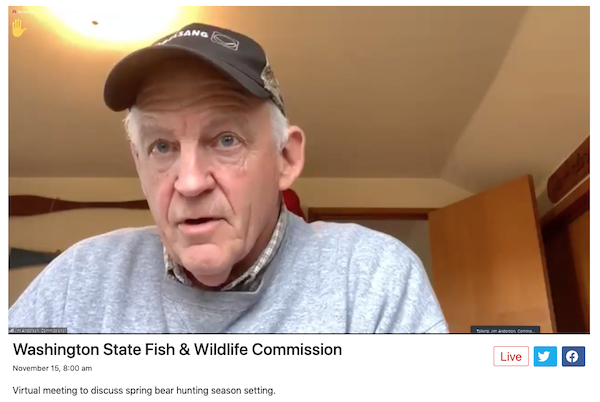WDFW Commission Hears More About Spring Bear Hunt Ahead Of Vote
You couldn’t quite call them fireworks, but there certainly was some smoke this morning during a Washington Fish and Wildlife Commission discussion of the 2022 spring black bear permit hunt proposal.
The limited-entry season has been under scrutiny over the past year, even inciting an ultimately unsuccessful lawsuit to try and stop the 2021 edition, and this Friday the eight-member citizen panel will take a vote to authorize next year’s hunt.

Ahead of that decision, WDFW staffers worked extra hours and over weekends to prepare a large presentation to answer numerous questions raised by commissioners at their late October public briefing and comment.
The main points of contention center around state managers’ rationale for holding a season – primarily as a hunting opportunity with secondary and tertiary management benefits – and the scientific basis that shows it’s not harming the state’s large bear population.
WDFW monitors the median age of males and females that are harvested and percentage of females taken, tweaking permit levels as needed to keep them within certain guidelines.
Commissioner Fred Koontz said he reads “almost a plea for help” from WDFW’s carnivore specialists in the annual big game trends and status report about using those measures to base management around and said that with a sharp rise in harvest seen in 2019, he worried that WDFW wasn’t being cautious enough with the species.
While acknowledging managers use professional district wildlife biologists’ opinions in setting spring bear permit levels – 664 would be available in 2022, mostly in Northeast and Southeast Washington – Koontz also took issue with that method.
“It’s not based on a scientific model that’s really defendable. I’m not saying that’s wrong. I just think that the commission when it votes on this should realize what it is we’re making our decision on. No more, no less,” said the Duvall resident who was appointed to the commission by Governor Inslee at the start of the year.
That drew immediate and sustained pushback from WDFW’s black bear manager and three fellow commissioners.
“Commissioner Koontz, I do understand your position and I respect it. At the same time, to say that we’re not using a scientific model I think is in error. We are using a scientific model,” said the agency’s Stephanie Simek. “There is new technology out there and there is new methodology which we are exploring. I just want to push back a little bit because I don’t want the public to think we aren’t using a model. We are using a model.”
The “new technology” is hair snare traps and capture-collar operations that WDFW has begun using to collect bruin density data for large swaths of the state. Early data tells managers there are as many as 31 black bears per 100 square kilometers, or 38 square miles, in Northeast Washington to as few as 7 in Southwest Washington, with an average of 20 in surveyed Westside habitat and 19 in Eastside habitat.
An animated Commissioner Molly Linville said the panel was “going down an extremely slippery slope” as getting so far into the weeds wasn’t its role and that it could trust its staffers’ assessments.
Linville, a Douglas County rancher, spoke to her long relationship with Simek dating back to the Wolf Advisory Group.

“I can tell you from personal experience that if she thought something was going on with this population that the commissioners need to be aware of, she would look us in the eye, she would say it and she would hold her ground. She has looked me in the eye on multiple occasions, said very difficult things to me and held her position. And I trust that she would do that in this case. We are using science. Department staff are the scientists. They are the scientists that we listen to and I trust the science that’s coming out of the department,” she said.
Linville felt the commission’s and WDFW staff’s time was being wasted and stated, “I don’t appreciate it.”
Jim Anderson of Buckley also said he didn’t think it was true that WDFW wasn’t following a scientific model.
“I think there’s always room for questions, but at some point the reason we have a professional staff is to have a professional staff and they give professional advice, and we’re getting that,” Anderson said.
Kim Thorburn of Spokane, a retired local health official, noted that she was a population scientist and said getting an exact population count was very difficult. But she termed recent years’ harvest data showing reduced days needed to kill a bear a “strong surrogate of an increasing population.”
She said that spring bear hunts are a tool for managing human-bruin conflicts, and addressing timber damage and bear predation on deer fawns and elk calves.
WDFW’s presentation shed a little more light on this year’s study in the Blue Mountains, scene of an “alarming mortality rate” north of 80 percent among 125 collared elk calves. Seventy-six mortalities have been attributed to predation, with nine of those pinned on bears and another four to either bears or cougars based on DNA. Overall, 47 percent of mortalities were attributed to cougars, roughly in line with past research here, but the presentation adds that the significance of black bear predation can increase when wolves are in the area.
Thorburn said she trusted hunters were being selective to not harvest sows with cubs.
According to WDFW, which strongly advises spring hunters against taking them, just one of 145 bears taken in the 2021 hunt was shown to be a lactating female.
Thorburn said there was no evidence that cub orphaning was a problem or that it was harming the population.
“The question is a social one, not biologic,” she said.
Before Simek could continue with her presentation, Koontz took a moment to apologize and say he wasn’t questioning the science; he was instead pointing to the language in WDFW’s game status report on the efficacy of using bear age and sex data to determine relative population trends.
That particular part of the report was written by Rich Beausoleil and Lindsey Welfelt, the agency’s statewide bear and cougar specialists.
They write, “Unfortunately, median ages and percent female metrics cannot accurately detect population trajectory, so using these methods presents challenges and risk. Until we have a workable alternative, such as monitoring bear densities and calculating actual harvest rates, the agency will continue to use these metrics.”
“The trouble is, if we can’t question anything, then I don’t really know what our role is,” Koontz said. “We don’t need a commission. Please, please, I’m not trying to disrespect anybody, I’m just trying to ask questions. I’m really sorry.”
Vice Chair Barbara Baker said this was in fact the opportunity to ask questions, and she had one herself.
“I’ve heard staff say a few times that the science is there, the population is there for the spring hunt, so this decision pivots on social considerations. Did I get that wrong? Is that accurate?” Baker asked.
“That’s accurate,” confirmed Simek.
Simek pointed out that future hunts for all species are dependent on young-of-the-year animals being recruited into the adult population and that everyone from hunters to WDFW managers understands that.
She termed the spring hunt a “selective” one where hunters tend to not randomly shoot the first bear they see.
Simek said that WDFW could propose no-shooting-sow rules or institute weight restrictions, as in some of the other seven states with spring hunts, but WDFW assumes that hunters are ethical operators.
While Commissioner Don McIsaac of Hockinson did in fact express some interest in developing a rule barring the killing of a sow with cubs, Anderson warned against creating regulations where there wasn’t a clear need for them.
“I’m not convinced that we need that kind of rule,” Anderson said.

Koontz saw it differently.
“Jim, I hear what you just said. But the reality is there’s a lot of the public that is concerned about it,” he said.
He called for future 24-hour reporting and 72-hour pelt inspection requirements – currently it’s five days – claiming that accuracy in determining whether a bear was lactating diminishes after 72 hours, per friends of his who inspect bears in Alaska.
Per WDFWs presentation, the average time it took spring hunters to report was 68.6 hours, just under three days, “with some hunters having inspections the day of harvest or within a day.”
“Like it or not, it’s a social issue that we have many people concerned,” Koontz said, “and it would behoove us to try to allay those concerns rather than end up that this goes to the legislature or ballot initiative and all of a sudden we have a bigger problem than we ever imagined.”
The commission’s decision is expected Friday morning. The 2022 spring bear hunt is the first item on the agenda of their 8-10 a.m. meeting.
This bookie has raised the odds from late October’s even money to likely to pass, but there’s a not insignificant chance the vote could also end up as a four-four tie, in which the previous year’s season would carry forward, which potentially sets up a conundrum given that 2021’s regs were specifically for 2021.
